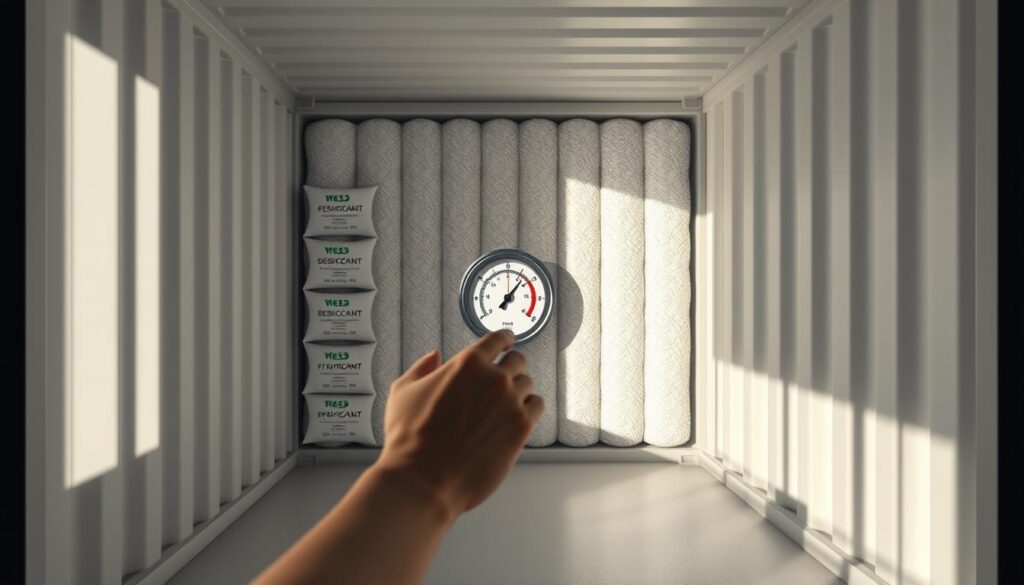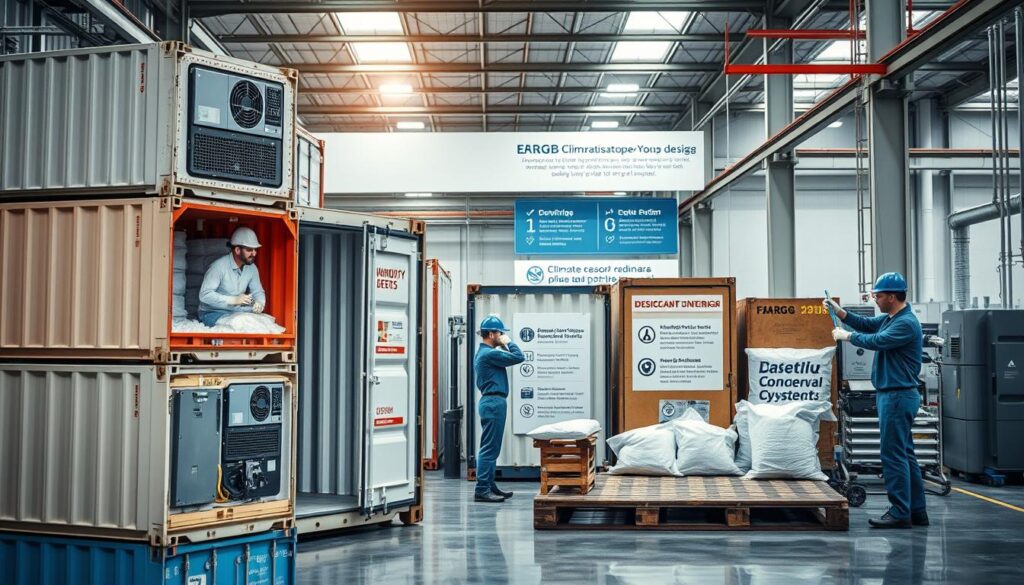Are you aware of the hidden costs associated with shipping goods in containers? Condensation damage can lead to significant financial losses due to ruined goods and costly repairs.
Condensation occurs when moisture accumulates inside the container, often due to temperature fluctuations or high humidity. Effective condensation prevention is crucial to safeguarding your cargo and maintaining the integrity of your shipping containers.
By understanding the causes of condensation and implementing simple yet effective strategies, you can prevent moisture damage and ensure your goods arrive at their destination in pristine condition.
Key Takeaways
- Understand the causes of condensation in shipping containers
- Learn effective strategies for preventing moisture damage
- Discover simple tips for maintaining a dry and secure shipping environment
- Reduce the risk of costly repairs and ruined goods
- Ensure your goods arrive at their destination in pristine condition
Understanding Container Condensation: The Silent Cargo Killer
The occurrence of condensation within shipping containers poses a substantial risk to cargo integrity. Moisture control in shipping containers is crucial to prevent damage. Condensation happens when the air reaches its dew point, causing water vapor to condense into liquid water. This can occur due to changes in temperature and humidity during transit.
What Causes Condensation in Shipping Containers?
Several factors contribute to condensation in shipping containers, including temperature fluctuations and high humidity levels. When a container is moved from a cool to a warm environment, the air inside can reach its dew point, leading to condensation. Understanding these factors is key to reducing humidity in containers.
The Costly Impact of Moisture Damage
Moisture damage can lead to significant financial losses. Cargo such as electronics, textiles, and metals can be ruined by condensation, resulting in costly repairs or replacements. For instance, rust on metal products can be prevented with proper moisture control strategies, saving shippers from potential losses.
The Science Behind Container Sweat: Temperature and Humidity Factors
The phenomenon of container condensation is deeply rooted in temperature and humidity factors. Condensation occurs when the air reaches its dew point, which is the temperature at which air becomes saturated with moisture and can no longer hold any more water vapor.
Dew Point and Relative Humidity Explained
Understanding dew point and relative humidity is crucial for container moisture management. Dew point is the temperature at which condensation happens, while relative humidity measures the amount of moisture in the air compared to its capacity. When the relative humidity is high, and the temperature drops, condensation is likely to occur.
How Climate Zones Affect Condensation Risk
Different climate zones significantly impact the risk of condensation. For instance, shipping containers moving through humid tropical regions are more prone to condensation than those in dry climates. Shippers can refer to detailed guides, such as the one found in this document, to understand how to protect their cargo in various climate conditions.
Key factors to consider include:
- The initial temperature and humidity of the cargo
- The climate conditions during transit
- The type of cargo being shipped
By understanding these factors, shippers can take proactive steps toeliminate condensationand ensure their cargo arrives in good condition.
Identifying Condensation Problems Before They Worsen
The key to maintaining cargo integrity lies in recognizing the signs of condensation early. Condensation in shipping containers can lead to significant damage if not addressed promptly. By being aware of the indicators and utilizing detection tools, shippers can take proactive measures to prevent costly issues.
Visual Indicators of Moisture Issues
Visual inspection is the first step in identifying potential condensation problems. Look for signs such as water droplets on the container walls or ceiling, rust on metal surfaces, and mold or mildew on cargo. These indicators suggest that moisture levels are too high, and corrective action is necessary.
Using Moisture Meters and Other Detection Tools
For a more precise assessment, moisture meters and other detection tools can be employed. These devices measure the humidity levels within the container, providing a quantitative assessment of the moisture risk. By using these tools, shippers can make informed decisions about the need for condensation prevention measures.
Here is a comparison of common detection tools:
| Detection Tool | Accuracy | Ease of Use |
|---|---|---|
| Moisture Meters | High | Easy |
| Hygrometers | High | Moderate |
| Visual Inspection | Variable | Easy |
By combining visual inspections with the use of detection tools, shippers can effectively identify and address condensation issues before they worsen, ensuring the safe transportation of their cargo.
Pre-Loading Strategies: Preventing Condensation Before It Starts
To keep your cargo dry, it’s crucial to implement pre-loading strategies that prevent condensation. Effective moisture control in shipping containers is a proactive process that begins before the cargo is even loaded. By understanding and implementing these strategies, shippers can significantly reduce the risk of moisture damage.
Proper Timing and Weather Considerations
One of the key factors in preventing condensation is timing. Shipping during periods of low humidity can significantly reduce the risk of moisture accumulation. Additionally, understanding the weather conditions along the shipping route and at the destination can help in planning. For instance, cargo shipped from a cool, dry climate to a warm, humid one is more susceptible to condensation. Planning the shipment during more favorable weather conditions can mitigate this risk.
Cargo Preparation Techniques

Preparing cargo properly is another critical step. This includes drying hygroscopic materials like wood and textiles before loading. Using drying agents or desiccants can help control moisture within the cargo. Moreover, ensuring that all cargo is free from visible moisture and is wrapped in vapor-proof materials can further reduce the risk of condensation.
Container Inspection and Preparation Checklist
Before loading, it’s essential to inspect the shipping container for any signs of damage or moisture. A thorough checklist should include verifying the container’s dryness, checking for any holes or rust, and ensuring that the container’s drainage system is functioning correctly.
“A well-maintained container is the first line of defense against condensation.”
By following this checklist, shippers can ensure that their containers are in optimal condition for cargo transport, thereby reducing the risk of condensation.
Implementing these pre-loading strategies can significantly enhance moisture control in shipping containers, ultimately protecting the cargo from damage and ensuring that it reaches its destination in optimal condition.
How to Keep a Shipping Container from Condensating During Transit
Transit is a critical period for containerized cargo, and managing condensation effectively is key to preventing damage. During this phase, containers are exposed to varying temperatures and humidity levels, which can lead to moisture accumulation inside the container.
Professional Moisture Control Solutions
For shippers looking to protect their goods from moisture damage, professional moisture control solutions offer a reliable and effective approach. These solutions are designed to reduce humidity in containers and prevent condensation.
Desiccants and Dehumidifiers: Types and Applications
Desiccants and dehumidifiers are widely used to control moisture in shipping containers. Desiccants absorb moisture from the air, while dehumidifiers remove excess moisture. The choice between these two options depends on the specific needs of the shipment and the container’s conditions. For instance, desiccants are often used for moisture-sensitive goods, whereas dehumidifiers are more effective in extremely humid environments.
Ventilation Systems and Their Effectiveness
Ventilation systems are another effective method for moisture-proofing shipping containers. By improving air circulation, these systems help to reduce moisture buildup and prevent condensation. Ventilation systems can be particularly useful for shipments that are prone to moisture damage, such as agricultural products or machinery.
DIY Condensation Prevention Methods for Budget-Conscious Shippers
Not all shippers have the budget for professional moisture control solutions. Fortunately, there are several DIY methods that can help eliminate condensation in storage containers during transit. These include using silica gel packets, ensuring proper packaging, and maintaining a clean and dry container.
- Use silica gel or other desiccants to absorb moisture.
- Ensure cargo is properly packaged to allow for air circulation.
- Keep the container clean and dry before loading.
By implementing these strategies, shippers can significantly reduce the risk of condensation damage during transit, protecting their goods and ensuring they arrive at their destination in good condition.
Cargo-Specific Condensation Prevention Techniques
Understanding the specific condensation prevention needs of various cargo types is key to successful shipping. Different cargoes have unique requirements to prevent moisture damage during transit.
Protecting Hygroscopic Goods
Hygroscopic goods, such as wood, paper, and textiles, absorb moisture from the air, making them particularly susceptible to condensation damage. To protect these goods, it’s essential to maintain a dry environment within the shipping container. Using desiccants or moisture-absorbing materials can help control humidity levels. Additionally, wrapping these goods in vapor barrier materials can prevent moisture absorption.
Metal Products and Electronics Protection
Metal products and electronics are vulnerable to corrosion and damage from condensation. To mitigate this risk, use volatile corrosion inhibitors (VCIs) or desiccant bags within the packaging. Ensuring that the shipping container is dry before loading and using moisture-resistant packaging materials can also help prevent damage.
Food and Agricultural Products Considerations
For food and agricultural products, maintaining a controlled environment is critical to prevent spoilage and contamination. Using reefer containers or containers with ventilation systems can help regulate temperature and humidity. It’s also crucial to inspect these products regularly during transit and ensure that packaging is moisture-resistant and secure.
Effective condensation prevention for various cargo types requires a tailored approach. The following table summarizes key strategies for different cargo categories:
| Cargo Type | Condensation Prevention Strategies |
|---|---|
| Hygroscopic Goods (Wood, Paper, Textiles) | Desiccants, vapor barrier materials, dry environment |
| Metal Products and Electronics | VCIs, desiccant bags, moisture-resistant packaging |
| Food and Agricultural Products | Reefer containers, ventilation systems, moisture-resistant packaging |

By implementing these cargo-specific condensation prevention techniques, shippers can significantly reduce the risk of moisture damage and ensure their goods arrive at their destination in optimal condition.
Moisture-Resistant Packaging Materials and Techniques
To safeguard cargo from moisture damage, shippers must consider advanced packaging materials and techniques. Effective moisture-proofing shipping containers begins with the right packaging choices, which play a critical role in maintaining dry conditions inside the container.
The use of appropriate packaging materials can significantly reduce the risk of condensation damage. This involves understanding the types of materials available and their applications.
Vapor Barrier Options and Applications
Vapor barriers are materials that prevent moisture from passing through them. They are crucial in container moisture management, especially for goods sensitive to humidity.
Common vapor barrier options include:
- Polyethylene sheets
- Aluminum foil linings
- Specialized vapor barrier films
These materials can be used to line containers or wrap around cargo to create a moisture barrier.
| Material | Description | Application |
|---|---|---|
| Polyethylene Sheets | Flexible, waterproof sheets | Container lining, cargo wrapping |
| Aluminum Foil Linings | Reflective, moisture-resistant linings | Container lining, thermal insulation |
| Vapor Barrier Films | Specialized films designed to block moisture | Cargo wrapping, container lining |
Moisture-Absorbing Packaging Materials
In addition to vapor barriers, moisture-absorbing packaging materials play a vital role in eliminating condensation in storage containers. These materials absorb excess moisture from the air, reducing humidity levels.
Examples include:
- Silica gel packets
- Desiccant bags
- Moisture-absorbing pads
These materials are particularly useful in enclosed spaces like shipping containers.
By combining vapor barrier options with moisture-absorbing materials, shippers can significantly enhance their container moisture management strategies, ensuring that cargo arrives at its destination in optimal condition.
Container-Specific Prevention Strategies
Understanding the specific characteristics of your shipping container is crucial for developing an effective condensation prevention strategy. Different types of containers have unique features that influence condensation risk.
Dry Containers vs. Refrigerated Containers
Dry containers and refrigerated containers require different approaches to condensation prevention. Dry containers need proper ventilation to prevent moisture buildup, while refrigerated containers must maintain a consistent refrigerated temperature to prevent condensation on cargo. Proper insulation and temperature control are key to preventing condensation in refrigerated containers.
Open-Top and Flat-Rack Container Considerations
Open-top and flat-rack containers are more exposed to the elements, increasing the risk of condensation. Using waterproof covers and ensuring proper drainage can help mitigate this risk. It’s also essential to secure cargo properly to prevent shifting during transit, which can contribute to moisture accumulation.
“The right packaging can make all the difference in preventing condensation damage during shipping.” – Expert in Shipping and Logistics
Used vs. New Container Moisture Challenges
Used containers may have existing moisture issues or damage that can increase condensation risk. Inspecting used containers thoroughly before use and applying rust prevention treatments can help. New containers, while generally in better condition, still require proper preparation and maintenance to prevent condensation.
By understanding the specific needs and challenges of different container types, shippers can implement effective condensation prevention strategies, reducing the risk of cargo damage and ensuring a smoother shipping process.
Seasonal Adjustments for Effective Moisture Control
Effective moisture control in shipping containers requires a nuanced understanding of seasonal changes. As weather patterns shift, the risk of condensation and moisture damage can vary significantly, necessitating adaptive strategies to maintain cargo integrity.
Summer vs. Winter Shipping Challenges
Shipping during different seasons presents unique challenges. In the summer, high temperatures and humidity levels can lead to increased moisture accumulation inside containers. Conversely, winter shipping exposes containers to cold temperatures, potentially causing condensation as containers pass through different climate zones.
Understanding these seasonal dynamics is crucial for effective container moisture management. In summer, it’s essential to monitor humidity levels closely and use desiccants or other moisture-absorbing materials to keep the cargo dry. In winter, ensuring that containers are properly sealed and protected from cold air can help mitigate condensation risks.
Adapting Prevention Strategies to Weather Conditions
Adapting prevention strategies to weather conditions is vital for maintaining optimal moisture levels. This involves selecting the right packaging materials, such as vapor barriers or moisture-resistant wraps, based on the anticipated weather conditions during transit.
For instance, during humid summer months, using moisture-absorbing packaging can help keep cargo dry. In contrast, during cold winter months, ensuring that containers are well-insulated and protected from freezing temperatures can prevent moisture-related damage.
| Season | Primary Challenges | Prevention Strategies |
|---|---|---|
| Summer | High temperatures and humidity | Use desiccants, moisture-absorbing materials, and ensure good ventilation |
| Winter | Cold temperatures and potential for condensation | Ensure containers are properly sealed, use insulation, and protect from cold air |
Long-Term Storage: Preventing Rust and Corrosion
Rust and corrosion are significant threats to shipping containers used in long-term storage, necessitating proactive prevention strategies. When containers are stored for extended periods, the risk of moisture accumulation increases, creating an environment conducive to rust and corrosion.
To mitigate these risks, it’s essential to implement effective maintenance routines and utilize cost-effective rust prevention treatments.
Maintenance Routines for Stored Containers
Regular inspections are crucial for identifying potential issues before they escalate. A well-maintained container is less likely to suffer from rust and corrosion. Key maintenance tasks include:
- Regularly inspecting the container for signs of damage or wear.
- Ensuring the container is clean and free of debris.
- Applying rust-inhibiting coatings to vulnerable areas.
As emphasized by industry experts, “Regular maintenance is not just about preventing rust; it’s about ensuring the overall integrity of the container and its contents.”
“The best way to prevent rust is to keep your containers clean, dry, and well-maintained.”
Cost-Effective Rust Prevention Treatments
Several cost-effective treatments can be applied to prevent rust and corrosion. These include:
| Treatment Type | Effectiveness | Cost |
|---|---|---|
| Rust-inhibiting coatings | High | Moderate |
| Desiccant packets | Moderate | Low |
| VCI (Volatile Corrosion Inhibitor) products | High | Moderate to High |
Choosing the right treatment depends on the container’s condition, storage environment, and the nature of the goods stored. Moisture-proofing shipping containers is a critical step in eliminating condensation and preventing rust.
Conclusion: Creating Your Comprehensive Condensation Prevention Plan
Effective container moisture management is crucial to preventing costly damage during shipping. By understanding the causes of condensation and implementing proactive measures, you can protect your cargo and ensure a successful shipment.
To create a comprehensive condensation prevention plan, consider the strategies outlined in this guide, including proper cargo preparation, professional moisture control solutions, and cargo-specific techniques. Regular maintenance and inspections can also help identify potential issues before they become major problems.
By following these condensation prevention tips and adapting to changing weather conditions, you can minimize the risk of moisture damage and keep your shipping container dry. Implementing these measures will help you achieve a successful shipment and maintain the integrity of your cargo.
To keep a shipping container from condensating, focus on maintaining a dry environment, using moisture-resistant packaging materials, and monitoring temperature and humidity levels. By taking these steps, you can ensure a safe and secure shipment.

